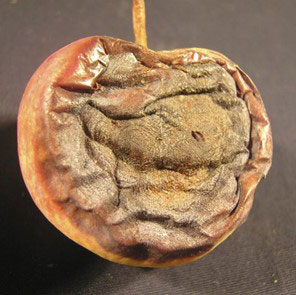Apple Bitter Rot
Contact
Plant Diagnostician
Phone: (479) 575-2727
Email: ssmith@uada.edu
Jason Pavel
Diagnostician
Phone: (479) 575-7257
Email: jpavel@uada.edu
University of Arkansas System Division of Agriculture
Cralley Warren Building
Room 16
2601 N. Young Ave.
Fayetteville, AR 72704
Apple Bitter Rot
Sherrie Smith and Jason Pavel October 10, 2022
Plant Health Clinic Disease Note: Issue 33

Apple Bitter Rot-Colletotrichum gloeosporioides
Photo by Sherrie Smith, University of Arkansas Cooperative Extension
Bitter rot is found wherever apples and pears are grown. Without fungicide protection, entire crops can be lost within a few weeks when environmental conditions favor the disease. Colletotrichum gloeosporioides, teleomorph Glomerella cingulata is the causal agent. Initial symptoms are tiny gray-brown flecks on the fruit. Lesions usually do not develop further until the fruit begins to ripen. Conidial type lesions are circular and become sunken as they enlarge. Acervuli, (fruiting bodies), are produced in concentric circles around the infection point. Perithecial type lesions are usually not sunken and are a darker brown color. Both types of lesions extend to the core in a cone shape. Some fruit mummify and remain attached to the tree throughout the winter while others drop. Leaf lesions begin as small red flecks that enlarge to irregular brown spots. Badly infected leaves drop prematurely.
Good sanitation is a key element in controlling Bitter rot. Remove all diseased fruit, leaves, and any cankered limbs from the orchard. No commercial cultivar is resistant, so fungicides should be applied at 10–14-day intervals, starting at green tip in the spring. Aprovia, Luna Sensation, Flint, and Pristine, are most effective against Bitter rot, although Captan also gives good control for homeowners if applied as directed.
Take Aways:
- Clean up all diseased fruit.
- Begin fungicides at green tip.
This work is supported by the Crop Protection and Pest Management Program [grant no. 2017-70006- 27279/project accession no. 1013890] from the USDA National Institute of Food and Agriculture.
Follow us on Facebook! UAEX Plant Health Clinic